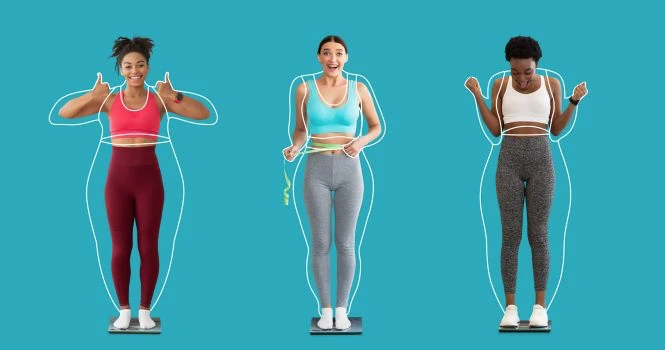Discover Your Ideal Weight: Comprehensive Height and Weight Chart for All Ages

Whether you’re a concerned parent tracking your child’s growth or an adult trying to maintain a healthy lifestyle, in this article, we are covering it all.
These Height Weight Charts guide you through the average height and weight ranges for different age groups. These charts are not just about numbers; they are a reflection of your health and well-being.
For growing kids, these charts ensure they are on the right track in terms of development.
For Adults, it’s about being in the normal weight range according to your height, while steering away from midsection fat and leading a healthy life.
These charts can help you catch growth disorders or nutritional deficiencies before they can have lasting effects.
Remember, comprehensive health assessment should take into account a range of factors beyond just height and weight. Read On..
Ideal Height-Weight Charts for Children and Adolescents
| Age | Boys Height (inches) | Boys Weight (lbs) | Girls Height (inches) | Girls Weight (lbs) |
| 2 years | 34 | 28 | 34 | 27 |
| 3 years | 37 | 33 | 37 | 32 |
| 4 years | 40 | 36 | 40 | 36 |
| 5 years | 43 | 42 | 43 | 42 |
| 6 years | 45 | 48 | 45 | 48 |
| 7 years | 48 | 54 | 48 | 54 |
| 8 years | 50 | 57 | 50 | 57 |
| 9 years | 53 | 64 | 52 | 64 |
| 10 years | 54.5 | 72 | 54.5 | 72 |
| 11 years | 56.5 | 81 | 57 | 86 |
| 12 years | 58.7 | 91 | 59.5 | 95 |
| 13 years | 61.5 | 101 | 61.7 | 105 |
| 14 years | 64.5 | 112 | 63.7 | 115 |
| 15 years | 66.9 | 123 | 64.3 | 117 |
| 16 years | 68.3 | 134 | 64.9 | 119 |
| 17 years | 69.1 | 142 | 65.3 | 120 |
| 18 years | 69.3 | 150 | 65.5 | 125 |
Note: One inch is equal to 2.54 centimeters.
Classification of Adults according to BMI
| BMI Category | BMI Range | Risk of Comorbidities |
| Underweight | Less than 18.5 | Low risk (but risk of other clinical problems increased) |
| Normal weight | 18.5 – 24.9 | Average |
| Overweight | >= 25.0 | |
| Pre-Obese | 25 – 29.9 | Increased risk |
| Obesity (Class I) | 30 – 34.9 | High risk |
| Obesity (Class II) | 35 – 39.9 | Very high risk |
| Obesity (Class III) | 40 or greater | Extremely high risk |
Ideal Height-Weight Charts for Men
It’s important to know that there’s a wide range of healthy body types among men, and factors such as muscle mass can affect what’s healthy for an individual.
The following list is of general range of weights for men at various heights, along with an ideal BMI range of 18.5 to 24.9.
| Height (feet & inches) | Height (cm) | Weight Range for BMI 18.5 to 24.9 (lbs) | Weight Range for BMI 18.5 to 24.9 (kg) |
| 5’0″ | 152 | 95 – 128 | 43 – 58 |
| 5’1″ | 155 | 101 – 135 | 46 – 61 |
| 5’2″ | 157 | 104 – 141 | 47 – 64 |
| 5’3″ | 160 | 107 – 148 | 49 – 67 |
| 5’4″ | 162 | 110 – 155 | 50 – 70 |
| 5’5″ | 165 | 114 – 162 | 52 – 74 |
| 5’6″ | 167 | 118 – 169 | 54 – 77 |
| 5’7″ | 170 | 121 – 176 | 55 – 80 |
| 5’8″ | 172 | 125 – 183 | 57 – 83 |
| 5’9″ | 175 | 128 – 190 | 58 – 86 |
| 5’10” | 178 | 132 – 197 | 60 – 89 |
| 5’11” | 180 | 136 – 204 | 62 – 93 |
| 6’0″ | 183 | 140 – 211 | 64 – 96 |
| 6’1″ | 185 | 144 – 218 | 65 – 99 |
| 6’2″ | 188 | 148 – 225 | 67 – 102 |
| 6’3″ | 190 | 152 – 233 | 69 – 106 |
| 6’4″ | 193 | 156 – 240 | 71 – 109 |
Understanding Men’s Body Shapes: Rectangle, Triangle, Oval, Rhomboid
Body shapes refer to the distribution of body fat and muscle at various points in the body. Men can have a variety of body shapes, and here are a few common ones:
- Rectangle: Also known as the “Ectomorph.” Individuals with a rectangular body shape tend to have a similar width at the shoulders, waist, and hips. They usually have a more linear appearance, and may struggle to gain weight and muscle.
- Triangle: This body shape is characterized by hips that are wider than the chest and shoulders. It’s often seen in men who have a tendency to gain weight around the stomach area.
- Oval: Oval-shaped bodies are rounded, with a larger waistline. The weight is generally distributed around the middle of the body, with shoulders and hips being narrower in comparison.
- Rhomboid: The rhomboid body shape is characterized by broad shoulders and chest, with a narrower waist. This shape is often considered athletic and is common among individuals who engage in regular strength training.
Understanding your body shape can be helpful for setting realistic fitness goals and for choosing clothing that flatters your natural shape.
It’s also relevant for understanding how your body shape might impact your health, as certain shapes may be associated with a higher risk of certain health conditions.
For instance, carrying excess weight around the midsection (as in the oval shape) is associated with an increased risk of heart disease and diabetes.
Ideal Height-Weight Charts for Women
As with men, there’s a wide range of healthy body types among women.
The following table lists a general range of weights for women at various heights, based on an ideal BMI range of 18.5 to 24.9.
| Height (feet & inches) | Height (cm) | Weight Range for BMI 18.5 to 24.9 (lbs) | Weight Range for BMI 18.5 to 24.9 (kg) |
| 4’10” | 147 | 91 – 119 | 41 – 54 |
| 4’11” | 150 | 94 – 124 | 43 – 56 |
| 5’0″ | 152 | 97 – 128 | 44 – 58 |
| 5’1″ | 155 | 100 – 132 | 45 – 60 |
| 5’2″ | 157 | 104 – 136 | 47 – 62 |
| 5’3″ | 160 | 107 – 141 | 49 – 64 |
| 5’4″ | 162 | 110 – 145 | 50 – 66 |
| 5’5″ | 165 | 114 – 150 | 52 – 68 |
| 5’6″ | 167 | 117 – 155 | 53 – 70 |
| 5’7″ | 170 | 121 – 159 | 55 – 72 |
| 5’8″ | 172 | 125 – 164 | 57 – 74 |
| 5’9″ | 175 | 128 – 169 | 58 – 77 |
| 5’10” | 178 | 132 – 174 | 60 – 79 |
| 5’11” | 180 | 136 – 179 | 62 – 81 |
| 6’0″ | 183 | 140 – 184 | 64 – 83 |
Understanding Women’s Body Shapes: Pear, Apple, Hourglass
Women’s bodies tend to have varying distributions of fat and muscle, leading to different body shapes. The common ones are;
- Pear (Triangle): Women with a pear body shape have hips that are wider than their bust and shoulders. They tend to carry weight in the hips and thighs, and often have a well-defined waist.
- Apple (Oval): An apple body shape is characterized by a wider waist and midsection compared to the hips and shoulders. Women with this shape tend to carry excess weight in the abdominal area.
- Hourglass: This body shape is characterized by hips and bust being nearly equal in width, with a narrower waist. Women with an hourglass shape tend to have fat distributed more evenly between the upper and lower body.
Understanding one’s body shape is not just about aesthetics; it can also have health implications. For example, carrying excess weight in the abdominal area (apple shape) is associated with a higher risk of heart disease and diabetes.
Knowing your body shape can also help in making informed choices about diet, exercise, and clothing styles that suit your body type.
The Role of Height and Weight in Health Assessment
Height and weight are fundamental measurements used in health assessment because they provide a basic understanding of a person’s body size and composition.
The combination of height and weight can be used to calculate the Body Mass Index (BMI), which is a commonly used metric to assess whether a person has a healthy body weight for a given height.
Let’s look into the logic and reasoning behind the role of height and weight in health assessment:
1. Understanding Growth Patterns in Children and Adolescents:
Monitoring height and weight is crucial for understanding how children and adolescents are growing. Patterns in height and weight can be indicative of nutritional status, and abnormalities can be signs of health issues or developmental disorders.
2. Body Mass Index (BMI):
BMI is calculated by dividing a person’s weight in kilograms by the square of height in meters. While BMI doesn’t measure body fat directly, it helps to estimate whether a person is underweight, normal weight, overweight, or obese.
This can be useful for identifying people at risk of certain diseases that are associated with extreme body weights.
3. Nutritional Status:
Being underweight can be a sign of malnutrition or other health problems, while being overweight can put a person at risk for chronic diseases such as diabetes, heart disease, and some cancers.
Understanding where a person’s weight lies in relation to their height can give healthcare providers information about their nutritional status and general health.
4. Disease Risk Assessment:
Many chronic diseases are associated with being significantly overweight or underweight. Tracking height and weight allows healthcare professionals to assess risk and provide guidance on lifestyle changes that may reduce the risk of these diseases.
5. Dosage of Medication:
In some cases, medication dosages are based on a person’s weight or body surface area, which is calculated using both height and weight. This is especially common in pediatric medicine.
6. Fitness and Exercise Programs:
When embarking on a fitness or exercise program, understanding a person’s height and weight can be important for setting realistic goals and tracking progress.
7. Psychological Well-being:
Extreme body weights can sometimes be indicative of mental health issues such as depression or eating disorders. Monitoring changes in weight, in conjunction with other assessments, can be an important part of mental health care.
8. Surgical and Clinical Procedures:
Height and weight are important for clinical procedures, such as ensuring the proper fit of medical devices, or for assessing the risks and benefits of surgical interventions, especially in weight-loss surgery.
It’s important to note that while height and weight are useful tools in health assessment, they are only part of the picture.
Body composition, distribution of fat, muscle mass, bone density, family history, and lifestyle are also important factors in assessing a person’s health.
Moreover, BMI has its limitations, as it does not differentiate between muscle and fat and may not always accurately reflect the health status of individuals with higher muscle mass or certain ethnic backgrounds.
Therefore, a comprehensive health assessment should take into account a range of factors beyond just height and weight.
Factors Influencing ‘Ideal Weight’
1. Gender Differences in Weight Distribution:
- Fat Distribution: Generally, men and women tend to store fat in different areas of the body. Men are more likely to store fat in the abdominal area, often referred to as an “apple” shape, while women tend to store fat in the hips and thighs, giving a “pear” shape.
This difference is influenced by hormones, with testosterone playing a role in male fat distribution and estrogen in female fat distribution.
- Muscle Mass: Men typically have a higher percentage of muscle mass compared to women, which can affect weight. Muscle is denser than fat, so a person with more muscle mass may weigh more even if they are lean.
- Metabolism: The differences in muscle mass also affect the basal metabolic rate (BMR). Men usually have a higher BMR compared to women of the same age and weight, meaning they burn more calories at rest. This can influence what is considered an ideal weight for each gender.
2. Role of Genetics and Environment:
- Genetics: A person’s genetic makeup plays a significant role in determining their body shape, size, and where they tend to store fat. Some individuals may be genetically predisposed to be lean, while others may be predisposed to carry extra weight.
- Environment: Environmental factors such as diet, physical activity, stress, and sleep can also impact a person’s weight. For example, a diet high in processed foods and sugary drinks can contribute to weight gain. Physical activity helps in maintaining muscle mass and regulating weight.
- Interaction: Genetics and environment interact in complex ways. For instance, a person with a genetic predisposition to obesity might maintain a healthy weight through a balanced diet and regular exercise, while another person without such a predisposition might gain weight if they have an unhealthy lifestyle.
3. The Impact of Age and Muscle Mass:
- Age: As people age, their metabolism typically slows down, and there is often a loss of muscle mass. This can lead to weight gain and changes in body composition even if the diet remains the same. Additionally, hormonal changes with age can affect weight distribution.
- Muscle Mass: Having a higher muscle mass can increase the BMR, meaning that people with more muscle burn more calories even when resting. This can be protective against weight gain.
As muscle mass tends to decline with age, maintaining it through resistance exercises can be important for managing weight.
It’s worth noting that the concept of an ‘ideal weight’ can be somewhat arbitrary, and what’s most important is maintaining a lifestyle that supports overall health and well-being. Moreover, focusing on health metrics and how you feel, rather than just the number on the scale, can often be more meaningful.
Deciphering Body Mass Index (BMI)
BMI, or Body Mass Index, is a widely used indicator that helps to categorize an individual’s body weight relative to their height. It is often used as a screening tool to identify possible weight problems in adults.
How is BMI Calculated?
BMI is calculated by dividing a person’s weight in kilograms by the square of their height in meters. The formula is:
BMI = weight (kg) / (height (m))^2
In the Imperial system (pounds and inches), the formula is slightly modified:
BMI = (weight (lbs) x 703) / (height (in))^2
Interpretation of BMI:
BMI values are usually interpreted as follows:
- Below 18.5: Underweight
- 18.5 to 24.9: Normal or Healthy Weight
- 25.0 to 29.9: Overweight
- 30 or higher: Obese
The Limitations of BMI:
While BMI is a simple and commonly used tool for assessing body weight, it has several limitations:
1. Lack of Distinction Between Muscle and Fat:
BMI does not differentiate between muscle mass and fat. For instance, a muscular person may have a high BMI but low body fat.
2. Variations Among Different Populations:
BMI values and categories were primarily developed based on data from European populations and may not be appropriate for all ethnic groups. For instance, Asian populations tend to have higher body fat percentages at lower BMIs compared to those of European descent.
3. Does Not Account for Fat Distribution:
BMI does not take into account where fat is distributed in the body. Abdominal fat, for example, is more closely linked to certain health risks than fat in other areas.
4. Not Always Indicative of Health:
A person with a BMI in the normal range may still have health problems related to their weight, while a person with a high BMI may be healthy.
5. Age and Sex Differences:
BMI does not account for changes in body composition with age or differences between sexes. Older adults, for example, tend to have more body fat than younger adults at the same BMI.
6. Not Suitable for Certain Populations:
BMI is not recommended for use in children (unless adjusted for age), pregnant women, or athletes, as these groups have different body compositions.
Given these limitations, it is important to consider BMI as just one factor among others in assessing an individual’s health and weight status.
It is often more useful when used in conjunction with other assessments, such as waist circumference, diet, physical activity, and family history.
Health Implications of Being Underweight or Overweight
Both being underweight and overweight or obese can have various health implications. Let’s look at the health risks associated with each:
1. Health Risks Associated with Being Underweight:
Being underweight can result from malnutrition, eating disorders, chronic diseases, or can sometimes be constitutional. Some health risks include:
a. Malnutrition: Being underweight can be an indicator of not getting enough nutrients, which can impair the functioning of various organs and systems.
b. Decreased Immune Function: Malnutrition can lead to a weakened immune system, making a person more susceptible to infections and illnesses.
c. Bone Health: Underweight individuals, particularly postmenopausal women, have an increased risk of osteoporosis and fractures.
d. Fertility Issues: Women who are underweight might face irregular menstrual cycles and infertility.
e. Anemia: Being underweight can be associated with lower levels of iron, leading to anemia.
f. Growth and Development Issues: In children and adolescents, being underweight can result in stunted growth and delayed development.
g. Increased Risk of Surgical Complications: Underweight individuals may have an increased risk of complications during surgery due to poor nutritional status.
2. Health Risks Associated with Being Overweight or Obese:
Being overweight or obese is typically a result of a caloric intake that exceeds the amount of energy expended by the body. This can be due to various factors including unhealthy eating habits, lack of physical activity, genetic factors, or underlying health conditions. Some health risks include:
a. Cardiovascular Diseases: There’s an increased risk of heart disease and stroke in overweight and obese individuals due to factors like high blood pressure, elevated cholesterol levels, and inflammation.
b. Type 2 Diabetes: Excess weight, especially around the abdomen, is strongly associated with insulin resistance and the development of type 2 diabetes.
c. Certain Cancers: Obesity is associated with an increased risk of various types of cancer, including breast, colon, and endometrial cancer.
d. Joint Problems: Carrying excess weight can put strain on the joints, increasing the risk of osteoarthritis.
e. Sleep Apnea and Breathing Problems: Excess weight, particularly around the neck, can lead to obstructive sleep apnea and other respiratory problems.
f. Fatty Liver Disease: Being overweight or obese can lead to the accumulation of fat in the liver, which can cause nonalcoholic fatty liver disease.
g. Mental Health Issues: There is often a psychological impact, with higher rates of depression, anxiety, and low self-esteem reported among overweight and obese individuals.
h. Increased Risk of Surgical Complications: Similar to being underweight, being obese can increase the risk of complications during surgery, but for different reasons such as increased stress on the heart and lungs.
In both cases, underweight and overweight or obese, it’s important to recognize that individual factors play a role, and consulting your doctor for personalized advice and strategies for managing weight in a healthy way is important.
Achieving and Maintaining Your Ideal Weight
Achieving and maintaining an ideal weight is not just about looking good, but it’s primarily about being healthy. Here’s how balanced nutrition, regular exercise, and mental health play crucial roles in weight management:
1. Balanced Nutrition: The Foundation of Weight Management
a. Caloric Balance: Achieving and maintaining the ideal weight requires balancing the calories consumed through food and beverages with the calories expended through metabolism and physical activity.
b. Nutrient-Dense Foods: Consuming nutrient-dense foods like vegetables, fruits, whole grains, and lean proteins can provide the necessary nutrients without an excessive caloric intake.
c. Portion Control: Paying attention to portion sizes can help prevent overeating and help in controlling caloric intake.
d. Hydration: Staying well-hydrated by drinking water can also help in managing hunger and improving metabolism.
e. Limiting Added Sugars and Unhealthy Fats: Cutting back on foods and drinks high in added sugars and unhealthy fats can reduce the intake of empty calories.
2. The Role of Regular Exercise in Weight Maintenance
a. Caloric Expenditure: Engaging in regular physical activity helps burn calories, which is essential for weight maintenance or loss.
b. Muscle Building: Physical activities, especially strength training, can help build muscle mass, which in turn increases the resting metabolic rate.
c. Improved Metabolic Health: Exercise has benefits beyond just calorie burning; it improves insulin sensitivity, reduces stress hormones, and has cardiovascular benefits.
d. Promotes Discipline and Routine: Regular physical activity can also build discipline and create a daily routine that supports weight management.
3. Importance of Mental Health in Weight Management
a. Stress Management: High levels of stress can lead to overeating or unhealthy eating habits. Managing stress through relaxation techniques, hobbies, or social connections is vital.
b. Mindful Eating: Being mindful and present while eating can help in recognizing true hunger and satiety cues, preventing overeating.
c. Positive Self-Image: Developing a positive self-image and realistic expectations are important for motivation and adherence to lifestyle changes.
d. Seeking Professional Help: In cases of mental health disorders such as depression, anxiety, or eating disorders, seeking the help of a psychologist, psychiatrist, or counselor is crucial.
e. Social Support: Having the support of family and friends or being part of a community can also play a significant role in weight management.
It is essential to remember that achieving and maintaining an ideal weight is an ongoing process that involves a combination of dietary, physical, and psychological factors.
Moreover, what’s ideal for one person may not be the same for another, so it is important to focus on health rather than just numbers on the scale.
Consulting healthcare professionals for personalized advice is always recommended.
Frequently Asked Questions (FAQs)
Is It Possible That You Have A Normal BMI But Your Waist-To-Hip-Ratio Shows That You Have Abdominal Obesity?
Waist circumference is measured at the midpoint between the lower border of the rib cage and the iliac crest.
It is a convenient and simple measurement that is unrelated to height, correlates closely with BMI and WHR and is an approximate index of intra-abdominal fat mass and total
body fat.
Changes in waist circumference reflect changes in risk factors for cardiovascular disease and other forms of chronic diseases. There is an increased risk of metabolic complications for men with a waist circumference ~ 102 cm, and women with a waist circumference ~ 88 cm.
Over the past 10 years , it has become accepted that a high WHR (> 1.0 in men and > 0.85 in women) indicates abdominal fat accumulation.
Apart From The Onset Of Chronic Diseases, How Does Being Overweight Impact Your Life?
It can have an impact in the following ways;
1. Physical Discomfort and Limited Mobility: Carrying extra weight can cause discomfort and limit mobility, making it difficult to engage in physical activities or even perform daily tasks.
2. Increased Fatigue: Being overweight can lead to increased fatigue and reduced energy levels.
3. Social Stigma and Discrimination: Overweight individuals may face social stigma, discrimination, or bullying which can negatively affect their mental health and social interactions.
4. Economic Impact: Being overweight can have an economic impact due to increased medical costs and, in some cases, reduced earning potential.
5. Sleep Problems: Excess weight, especially around the neck, can contribute to sleep apnea and other sleep disorders.
6. Body Image and Self-esteem Issues: Being overweight can affect one’s body image and self-esteem, sometimes leading to anxiety and depression.
Why Head Circumference Is Crucial for Children Along with Height and Weight
1. Monitoring Brain Growth: Head circumference is an indicator of brain size and development in infants and young children.
2. Identifying Potential Developmental Issues: Abnormal growth patterns in head circumference could be indicative of developmental disorders or conditions such as microcephaly or macrocephaly.
3. Assessing Nutritional Status: Along with height and weight, head circumference can help in assessing the nutritional status of a child, as malnutrition can affect brain development.
What is the Importance of Height and Weight Charts?
In Short, It is for the following,
1. Growth Monitoring: Height and weight charts are used to monitor growth over time, particularly in children, to ensure they are growing at a healthy rate.
2. Identifying Potential Health Issues: Deviations from expected growth patterns can be an early indicator of underlying health issues.
3. Individualized Assessment: These charts help in individualized assessment as they take into account age and sex, providing context to raw height and weight measurements.
4. Guiding Interventions: Physicians and healthcare professionals use these charts to guide interventions if a child is not growing as expected.
How Can I Increase My Height?
Height is primarily determined by genetics, but there are several factors especially during the growing years that can contribute to achieving your maximum potential height:
1. Proper Nutrition: Consuming a balanced diet rich in nutrients, especially calcium and vitamin D, is important for bone growth.
2. Physical Activity: Engaging in regular physical activities, especially those that involve stretching and high impact like swimming and basketball, can be beneficial for height growth during the growing years.
👉 Curious about how swimming may affect growth? Explore whether swimming can increase your height and what science says about it.
3. Adequate Sleep: During sleep, the body releases growth hormones. Ensuring that you get enough sleep during your growing years can be important for height.
4. Maintain Good Posture: Practicing good posture can help in elongating your spine.
5. Avoid Growth Inhibitors: Avoid substances like tobacco and excessive caffeine that can inhibit growth.
Note that after a certain age (usually late teens or early twenties), the growth plates close and height no longer increases.
What Is Overweight For A 12-Year-Old?
The determination of being overweight for a 12-year-old is generally based on Body Mass Index (BMI) percentiles which take into account the child’s age and gender.
A 12-year-old is typically considered overweight if their BMI is in the 85th percentile or higher but below the 95th percentile for children of the same age and sex.
Those in the 95th percentile or higher are considered obese.
How Can I Achieve And Maintain My Ideal Weight?
Achieving and maintaining ideal weight involves balanced nutrition, regular physical exercise, and mental well-being.
It’s important to consume a nutrient-dense diet, engage in regular physical activity, manage stress, and adopt a healthy lifestyle. Consulting healthcare professionals for personalized advice is recommended.
Why Do Men And Women Have Different Ideal Weight Ranges?
Men and women have different ideal weight ranges due to differences in body composition, distribution of muscle and fat, and hormonal differences.
Typically, men have a higher percentage of muscle mass compared to women and tend to accumulate fat around the abdomen, while women tend to have a higher percentage of body fat and accumulate it around the hips and thighs.
These physiological differences necessitate different weight ranges for optimal health. Additionally, women’s bodies need to prepare for the possibility of pregnancy and breastfeeding, which also impacts body composition.
What Is 150 To 190 Cm In Feet And Inches?
To convert a height range from centimeters (cm) to feet and inches, you can use the following conversion factors:
1 foot = 30.48 centimeters
1 inch = 2.54 centimeters
| Centimeters | Feet and Inches |
| 140 cm | 4 feet 7 inches |
| 141 cm | 4 feet 7.5 inches |
| 142 cm | 4 feet 8 inches |
| 143 cm | 4 feet 8.3 inches |
| 144 cm | 4 feet 8.7 inches |
| 145 cm | 4 feet 9 inches |
| 146 cm | 4 feet 9.5 inches |
| 147 cm | 4 feet 9.9 inches |
| 148 cm | 4 feet 10.3 inches |
| 149 cm | 4 feet 10.7 inches |
| 150 cm | 4 feet 11 inches |
| 151 cm | 4 feet 11.4 inches |
| 152 cm | 5 feet 0 inches |
| 153 cm | 5 feet 0.2 inches |
| 154 cm | 5 feet 0.5 inches |
| 155 cm | 5 feet 1 inch |
| 156 cm | 5 feet 1.4 inches |
| 157 cm | 5 feet 1.8 inches |
| 158 cm | 5 feet 2.2 inches |
| 159 cm | 5 feet 2.6 inches |
| 160 cm | 5 feet 3 inches |
| 161 cm | 5 feet 3.4 inches |
| 162 cm | 5 feet 3.8 inches |
| 163 cm | 5 feet 4.2 inches |
| 164 cm | 5 feet 4.6 inches |
| 165 cm | 5 feet 5 inches |
| 166 cm | 5 feet 5.4 inches |
| 167 cm | 5 feet 5.7 inches |
| 168 cm | 5 feet 6 inches |
| 169 cm | 5 feet 6.5 inches |
| 170 cm | 5 feet 7 inches |
| 171 cm | 5 feet 7.3 inches |
| 172 cm | 5 feet 7.7 inches |
| 173 cm | 5 feet 8 inches |
| 174 cm | 5 feet 8.5 inches |
| 175 cm | 5 feet 9 inches |
| 176 cm | 5 feet 9.3 inches |
| 177 cm | 5 feet 9.7 inches |
| 178 cm | 5 feet 10 inches |
| 179 cm | 5 feet 10.5 inches |
| 180 cm | 5 feet 11 inches |
| 181 cm | 5 feet 11.3 inches |
| 182 cm | 5 feet 11.7 inches |
| 183 cm | 6 feet 0 inches |
| 184 cm | 6 feet 0.4 inches |
| 185 cm | 6 feet 1 inch |
| 186 cm | 6 feet 1.2 inches |
| 187 cm | 6 feet 1.6 inches |
| 188 cm | 6 feet 2 inches |
| 189 cm | 6 feet 2.4 inches |
| 190 cm | 6 feet 2.8 inches |
| 191 cm | 6 feet 3.2 inches |
| 192 cm | 6 feet 3.6 inches |
| 193 cm | 6 feet 4 inches |
| 194 cm | 6 feet 4.3 inches |
| 195 cm | 6 feet 4.8 inches |
| 196 cm | 6 feet 5.2 inches |
| 197 cm | 6 feet 5.6 inches |
| 198 cm | 6 feet 6 inches |
| 199 cm | 6 feet 6.4 inches |
| 200 cm | 6 feet 6.7 inches |
![]()












